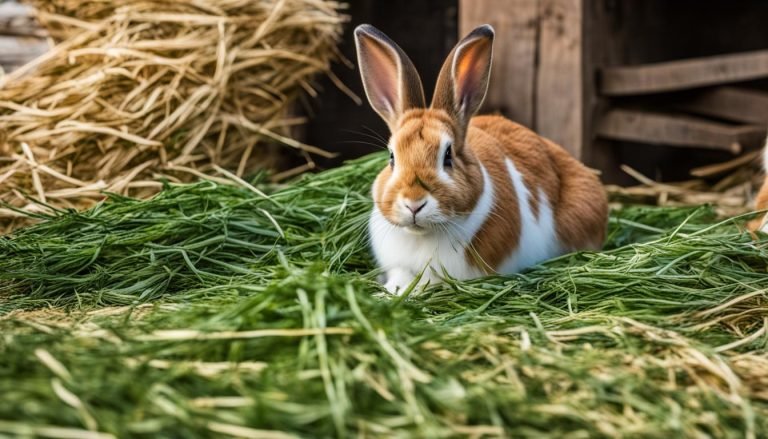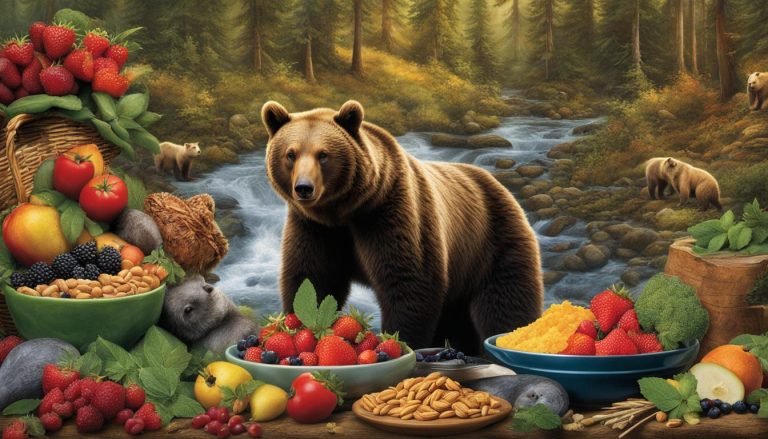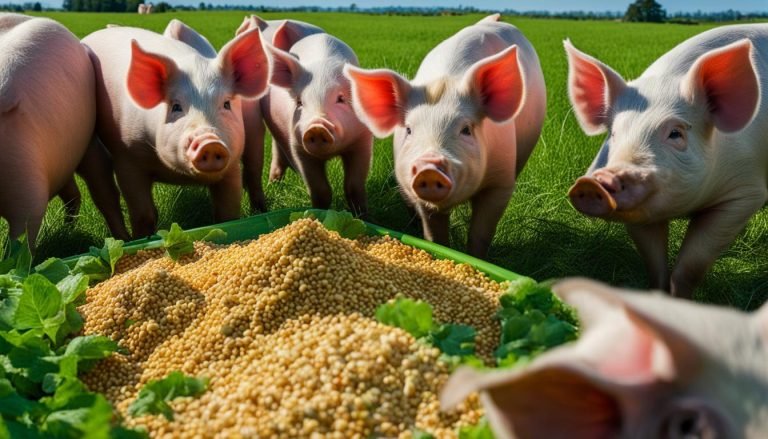What Do Lions Eat? The Lion’s Diet Explained
As the kings of the jungle, lions have captured our fascination for centuries.
Their majestic presence and impressive manes evoke a sense of awe and respect.
Yet, behind their beauty lies an intriguing world of hunting and feeding habits. In this section, we will explore the lion’s diet, uncovering their food preferences and feeding habits.
Lions are known for being carnivorous animals, meaning they primarily feed on meat.
They are apex predators, which means they are at the top of the food chain, and no other animal preys on them.
The lion’s diet consists of a variety of animals, including herbivores and other carnivores.
Despite their predatory nature, lions have unique feeding habits that differ from other carnivorous animals.
Factors such as pride dynamics and territorial behavior play a significant role in shaping their feeding patterns.
Additionally, lions are opportunistic feeders, which means they will take advantage of any available food source, including carrion.
In the following sections, we will delve deeper into the lion’s diet, exploring their natural predatory behavior, preferred prey, hunting strategies, and feeding habits.
We will also discuss their nutritional requirements and how they have adapted to survive in different environments. Finally, we will examine the impact of human-lion conflict on their diet and ongoing conservation efforts to protect their food sources.
Key Takeaways:
- Lions are carnivorous animals, with a diet primarily consisting of meat.
- Their feeding habits are influenced by factors such as pride dynamics and territorial behavior.
- Lions are opportunistic feeders and will scavenge for food if necessary.
- The lion’s diet includes a variety of animals, from small antelopes to large herbivores like zebras and wildebeests.
- Understanding the lion’s diet is crucial for their conservation, as human activities can impact their food sources and habitats.
Lion Quiz
How well do you know Lions? Test your knowledge below!

A Carnivorous Diet: Lions’ Natural Predatory Behavior
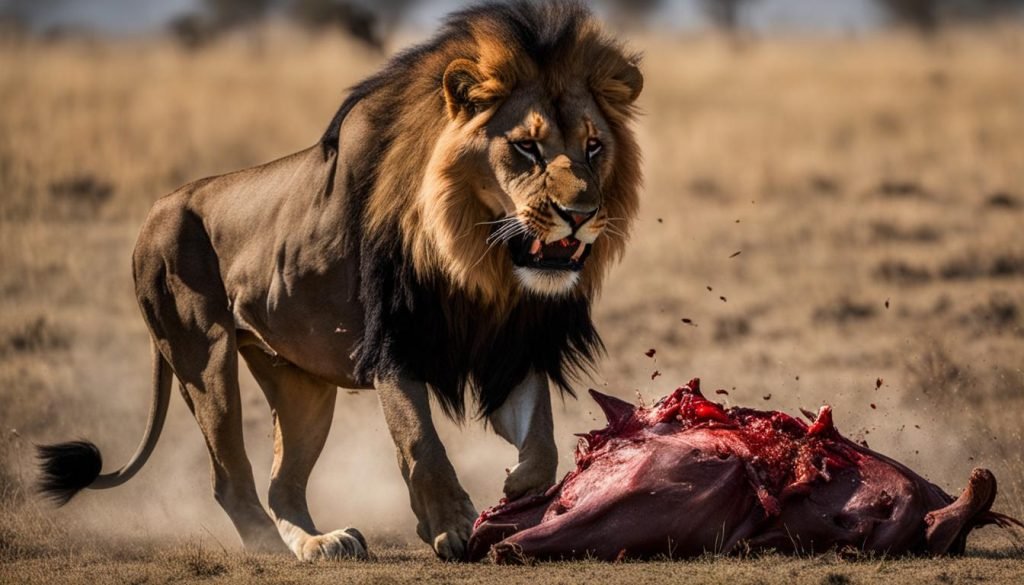
As carnivorous animals, lions have an instinct to hunt and feed on meat.
Their predatory behavior is finely honed, allowing them to capture prey with their impressive speed, strength, and agility.
Lion-hunting behavior is complex and varies depending on the circumstances. Lions often hunt in groups, known as prides, to increase their chances of a successful kill. The hunting process involves strategic planning, coordination, and communication among pride members.
Lion Hunting Techniques
Lions have several hunting techniques that they use to catch prey. Some of these techniques include:
- Stalking: Lions use their stealth and camouflage to stalk prey undetected. They move slowly and quietly, using cover to get closer to their target.
- Ambush: Lions may wait in hiding to surprise prey as they pass by. This technique requires patience and timing.
- Chase: Lions are known for their impressive speed and endurance, allowing them to chase down prey over long distances.
These techniques are often combined to increase the chances of success. For example, a lioness may stalk prey while other lions wait in ambush or chase the prey down.
Preferred Prey of Lions
Lions have a diverse range of potential prey, but their preferences vary depending on factors such as the size and strength of the pride. Some of the most common prey for lions include:
| Prey | Description |
|---|---|
| Zebra | Large herbivore with distinctive black and white stripes. |
| Wildebeest | A hooved mammal with a broad, flat muzzle. |
| Antelope | A group of small to medium-sized herbivores with curved horns. |
Lions may also prey on smaller animals like rabbits, hares, and birds. However, they typically require larger prey to sustain their energy needs.
The Hunting Strategies of Lions
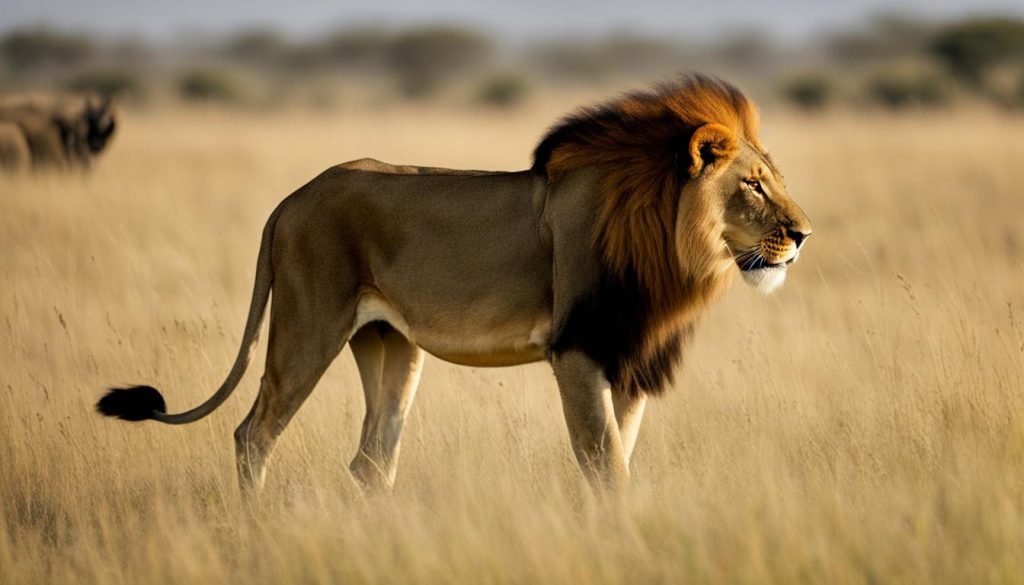
When it comes to hunting, lions have some of the most remarkable strategies that have evolved over generations. Despite being fierce and powerful animals, lions rely on their intelligence, teamwork, and cunning techniques to catch their prey.
One of the most common hunting strategies used by lions is called stalking. Stalking involves creeping up silently on prey, using natural terrain to remain concealed, and then pouncing on the prey once it is close enough. This technique requires patience and precision, as one wrong move could scare off the prey.
Lions also use ambush hunting, which involves waiting for prey to walk by a hiding spot, such as a bush or a tree, before attacking them. This technique is often used for smaller prey, such as antelopes, and requires precise timing to execute successfully.
Another hunting strategy employed by lions is known as the hunt-and-chase technique. This method involves chasing prey over long distances until the prey is exhausted and can no longer run. Once the prey is tired, the lions can move in for the kill.
Finally, lions also use a technique called cooperative hunting. This strategy involves members of pride working together to take down larger prey, such as zebras or wildebeests. By cooperating, the lions can take advantage of their size and strength to bring down prey that would otherwise be too large for a single lion to handle.
Overall, the hunting strategies of lions showcase their intelligence, coordination, and adaptability. By honing their skills over generations, lions have become some of the most effective predators in the animal kingdom.
The Preferred Prey of Lions
As apex predators, lions have a wide range of potential prey in their habitat. The size and distribution of the prey population often determine the success and survival of lion prides. Lions mainly hunt herbivores, such as ungulates, which are the primary prey for most large carnivores.
The most common prey for lions in Africa include zebras, wildebeests, and antelopes. Zebras are particularly favored by lions because of their large size, strength, and high nutritional value.
Wildebeests, on the other hand, are abundant in the open grasslands and provide a significant source of food for lions. Antelopes are also frequently hunted because of their abundance and their vulnerability to the lion’s stealthy approach.
Lions are opportunistic predators and will adapt their hunting strategies based on the availability of prey. In times of scarcity, they may target smaller prey, such as hares and birds. They also scavenge on carcasses of larger animals that they find in their habitat, especially during the dry season when food is scarce.
Although lions can hunt alone, they often hunt in groups, referred to as prides. This strategy increases the chances of a successful hunt, especially when targeting large prey. By working together, lions can easily isolate and capture their target animals, which are often faster and more agile.
Interestingly, lions also show a preference for hunting specific age groups of prey. In some cases, they may target young or old animals, which are easier to catch and subdue. This behavior is not only influenced by the availability of prey but also by the size and strength of the hunting pride.
In conclusion, the preferred prey of lions includes zebras, wildebeests, and antelopes, among others. Lions often hunt in groups, and their hunting strategies are often influenced by the availability of prey, the strength of the pride, and the age or size of the target prey.
The Importance of Lionesses in Hunting
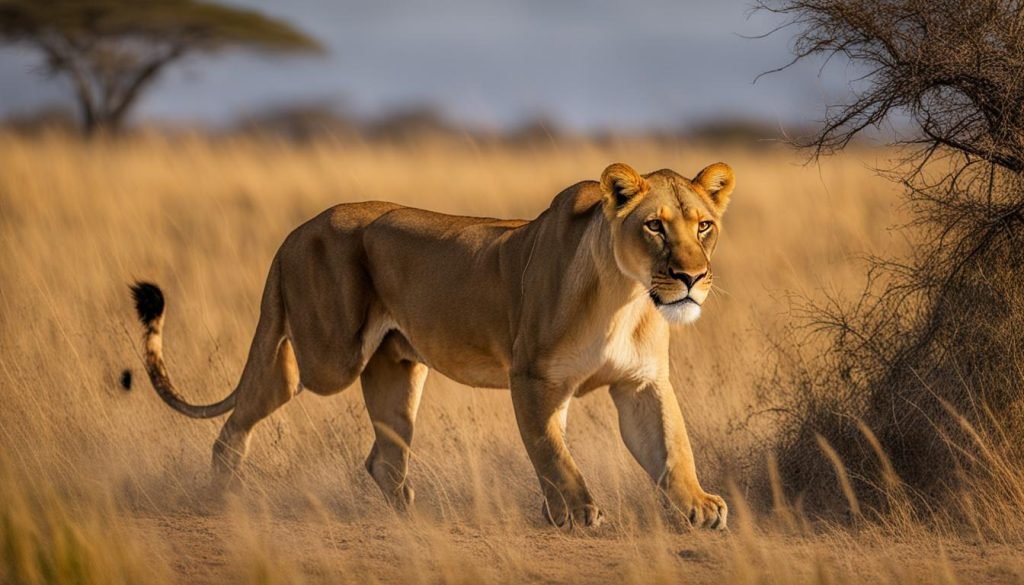
While lions are often thought of as fierce predators and the kings of the jungle, it is important to note that lionesses play a crucial role in the hunting process. Lionesses are the primary hunters in the pride, with males only occasionally participating in hunts.
The hunting behavior of lionesses is incredibly coordinated and strategic. They work together to stalk their prey, often using the cover of night to their advantage. Once they have identified a potential target, they will use their speed and agility to ambush it, making use of their powerful jaws and sharp claws to take it down.
One interesting aspect of lioness hunting behavior is their tendency to focus on smaller, more agile prey. This is partly due to their smaller size compared to male lions, but also because these types of prey require greater teamwork and coordination to catch.
It is also worth noting that lioness hunting behavior can vary depending on the needs of the pride. In times of scarcity, for example, they may be forced to take on larger or more dangerous prey.
In addition to their hunting skills, lionesses also play an important role in teaching younger generations of lions how to hunt and providing care for cubs. Without the invaluable contributions of lionesses, prides would not be able to thrive and survive.
The Feeding Habits of Lions
When it comes to feeding habits, lions have unique behaviors influenced by various factors. In this section, we will delve into the different feeding habits of lions and how they acquire their food.
As previously mentioned, lions are primarily carnivorous animals, meaning they consume meat exclusively. Their diet consists of a wide range of prey, including large herbivores like zebras and wildebeests, as well as smaller animals such as antelopes. Lions hunt their prey by using their natural predatory behavior and remarkable hunting strategies passed down from generations.
Once a kill has been made, the lion pride begins feeding. It’s important to note that the male lion, while instrumental in hunting, is not always present during feeding. Lionesses take charge of the division of labor and ensure that young cubs have access to food as well.
Interestingly, lions demonstrate a regurgitation behavior where they can bring up food they’ve previously consumed. This behavior is often observed in lionesses who have recently given birth. By regurgitating food, they can provide their cubs with a readily available and easy-to-digest source of nutrition.
While hunting is the primary source of food for lions, they are also opportunistic feeders, meaning they will take advantage of any available sources of food. This includes scavenging for food, particularly carrion.
Lions can survive for long periods without food, so scavenging provides them with an additional food source in times of scarcity.
| Feeding Habits of Lions | Description |
|---|---|
| Regurgitation | The act of bringing up food previously consumed to provide nutrients for cubs |
| Scavenging | Taking advantage of any available food source, particularly carrion |
It’s important to note that lion feeding habits can vary depending on pride dynamics and territorial behavior. This means that the amount of food available and the size of the pride can influence feeding habits significantly. Lions have adapted to survive in various environments, and their food preferences may differ depending on the habitat they live in.
“Lions are the only cats that work as a team to catch their prey. Lionesses do most of the hunting, but male lions are not idle.” – National Geographic
The Nutritional Requirements of Lions
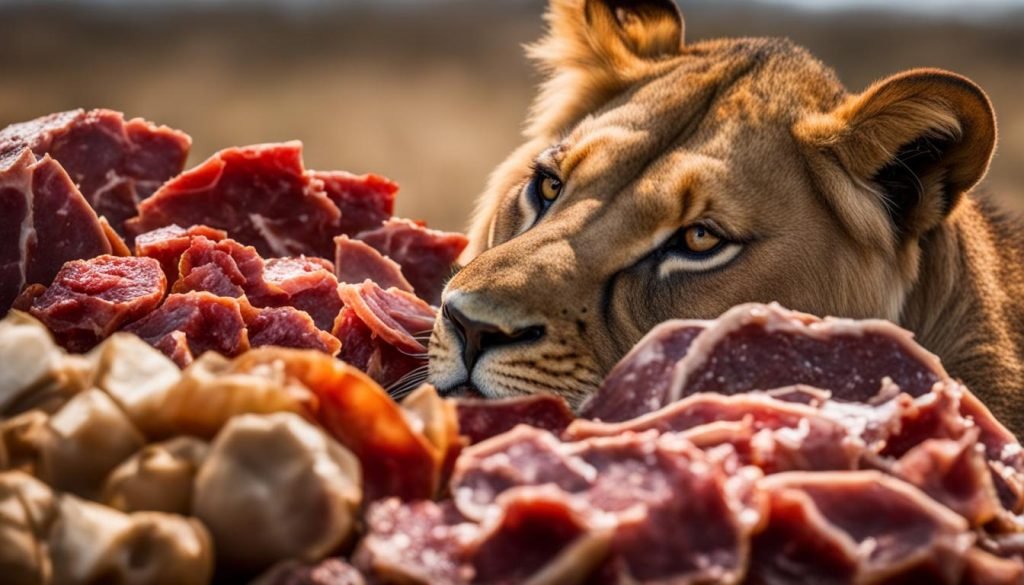
As carnivorous animals, lions require a specific balance of nutrients to maintain their health and vitality. The primary components of their diet are protein and fats, which are essential for their growth and development. The nutritional requirements of lions vary depending on their age, sex, and activity level.
Protein plays a crucial role in the lion’s diet, providing the necessary amino acids that support muscle growth and tissue repair. Animal protein is the primary source of protein for lions, and they require at least 20% of their daily diet to come from protein sources.
Fats are another essential component of the lion’s diet, providing the energy required for their daily activities. They also help in the absorption of vitamins and minerals. Lions obtain fats from the animal sources they hunt, and their diet should consist of at least 10% fat.
In addition to protein and fat, lions require a range of vitamins and minerals to maintain their health. These include vitamins A, D, E, and K, as well as calcium, phosphorus, and iron. Lions obtain these nutrients from the animals they consume, and a deficiency can result in serious health problems.
The Importance of a Balanced Diet
A balanced diet is crucial for the health and well-being of lions. In the wild, a lion’s diet can vary depending on the availability of prey, and they may not always obtain all the necessary nutrients from their food. As a result, they may need to consume a variety of prey animals to ensure they get a complete and balanced diet.
A lack of sufficient nutrients can lead to health problems, including stunted growth, weakened immune systems, and reproductive issues. In captivity, where their diet is more controlled, lions are at risk of overfeeding and obesity, which can also lead to health complications.
Lion Nutrition in Captivity
In captivity, lions are often fed commercial diets that are specifically formulated to meet their nutritional requirements. These diets consist of carefully selected ingredients, including meat, bones, and organ meats. Supplements are also added to ensure the lion’s nutritional needs are met.
However, there is ongoing debate about the adequacy of commercial diets for lions, as they may not provide the same nutritional value as the whole prey animals they would consume in the wild. Additionally, captivity can also lead to reduced activity levels, which can impact their overall health and nutritional needs.
While commercial diets can be beneficial for captive lions, it is important to ensure they receive a balanced and varied diet that meets their nutritional requirements. Regular monitoring of their health and body condition is also essential to ensure they are receiving adequate nutrition.
The Importance of Opportunistic Feeding: Lions and Carrion
As opportunistic feeders, lions are not picky when it comes to finding food. They will scavenge and eat carrion when there are no other options available. In fact, carrion can make up a significant portion of their diet in some cases.
While some may consider scavenging to be a less noble way of feeding than hunting, it can be a crucial survival strategy for lions in harsh environments. Carrion provides a readily available food source that requires minimal effort to obtain, conserving their energy for when they need to hunt.
“When food is scarce, scavenging can mean the difference between life and death for lions.”
Furthermore, carrion consumption is not limited to times of scarcity. Even when food is abundant, lions will still scavenge, demonstrating their adaptable feeding habits.
Interestingly, lions are not the only predators that feed on carrion. Other carnivorous animals, such as hyenas and vultures, will also scavenge for food. This can lead to competition and conflicts between species over access to carrion.
The Benefits and Drawbacks of Carrion Feeding
While scavenging for carrion provides lions with many benefits, there are also some drawbacks to this feeding strategy. One potential issue is the risk of consuming spoiled or diseased meat, which can result in illness or death. However, lions have evolved to have strong digestive systems that can handle decomposing meat, minimizing this risk.
Another concern with carrion feeding is the potential for conflict with other predators. As mentioned earlier, hyenas and vultures are also attracted to carrion, and they may become aggressive if lions try to claim a carcass. This can result in injury or death for all animals involved.
The Role of Carrion in Lion Conservation
Despite the potential risks and challenges, carrion still plays an important role in lion conservation efforts. In areas where lion populations are declining due to human activities or other factors, providing them with access to carrion can help to ensure their survival. This has been done successfully in some African parks and reserves, where carrion is placed strategically to attract lions away from human settlements, reducing the risk of conflict.
In summary, while hunting is the primary feeding method for lions, scavenging for carrion can also be an important survival strategy. Lions’ opportunistic feeding habits and ability to adapt to changing circumstances are essential attributes that contribute to their success as apex predators.
The Dietary Adaptations of Lions in Challenging Environments
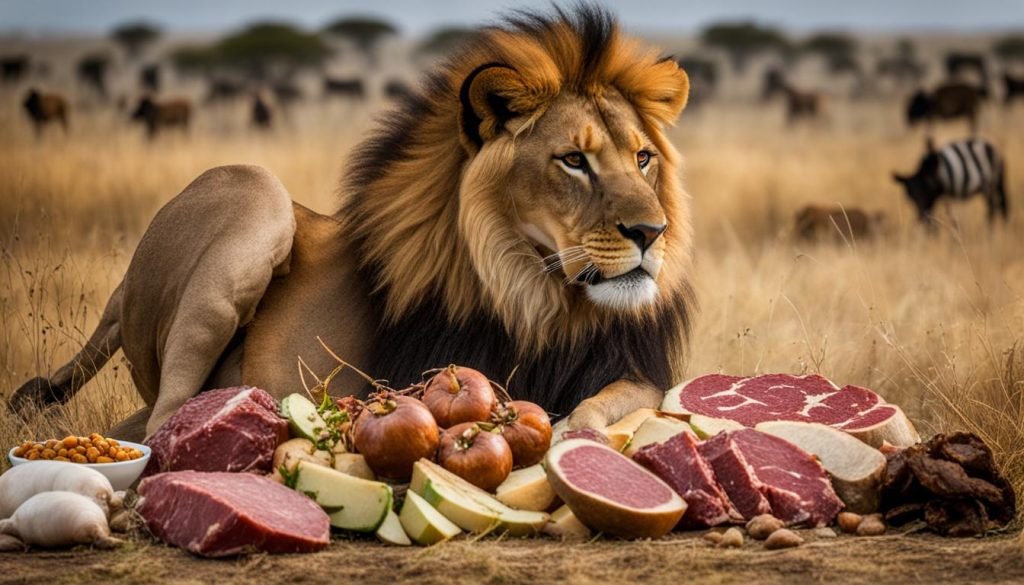
As opportunistic predators, lions have adapted their food preferences and feeding habits to survive in a variety of challenging environments. From the arid deserts of the Kalahari to the lush grasslands of the Serengeti, lions have learned to adapt to the food sources available within their habitat.
One of the most significant adaptations of lions is their ability to prey on a wide range of herbivores, including wildebeest, zebra, and buffalo. In areas where large prey is scarce, lions may also feed on smaller animals, such as hares and birds. These dietary adaptations allow lions to thrive in challenging and unpredictable environments.
Interestingly, research has shown that lions in different regions may have distinct food preferences and feeding behaviors. For example, in the dry savannas of East Africa, lions tend to feed on large herbivores such as wildebeest and zebra.
In contrast, lions living in the dense forests of West Africa may focus on smaller prey such as duikers and bush pigs. These adaptations demonstrate the remarkable flexibility of the lion’s diet and their ability to thrive in various environments.
Comparing Lion Food Preferences Across Habitats
| Habitat | Preferred Prey |
|---|---|
| Desert | Gemsbok, Springbok, Ostrich |
| Savanna | Wildebeest, Zebra, Buffalo |
| Forest | Duikers, Bush Pigs, Monkeys |
As shown in the table above, the preferred prey of lions varies significantly across different habitats. Lions living in the desert regions of Africa tend to prey on animals such as gemsbok, springbok, and ostrich, which are well-adapted to survive in arid environments.
Lions living in savanna habitats often target large herbivores such as wildebeest and zebra, which are well-suited to the open grasslands. Forest-dwelling lions may focus on smaller prey such as duikers, which can easily navigate the dense vegetation.
These adaptations demonstrate the remarkable flexibility of the lion’s diet and their ability to thrive in various environments. However, it is essential to note that human activities such as habitat destruction and poaching can significantly impact the food sources available to lions.
As such, conservation efforts are vital to protecting both the lions and their prey, ensuring the continued survival of these magnificent creatures in the wild.
Human-Lion Conflict: Impact on Diet
As a professional journalist, I have discovered that human-lion conflict poses significant challenges for both humans and lions. The impact of human activities can be seen in the diet of lions. When humans invade the natural habitats of lions, it affects their feeding habits, including changes in their food preferences and hunting patterns.
This conflict can lead to a shift from wild prey to domestic animals, which can result in lions attacking livestock and being targeted by humans in retaliation.
The conflict also leads to a decline in natural prey populations, as human activities such as hunting, poaching, and deforestation reduce the availability of food sources for lions. This decline in prey populations forces lions to adapt to new diets, often resulting in them preying on smaller animals or scavenging for food.
Furthermore, human-lion conflict affects the social dynamics of prides, leading to changes in hierarchical structures and territorial behavior.
Measures must be taken to reduce human-lion conflict to preserve the natural diet of lions. This can include creating wildlife corridors, implementing education and awareness programs, and involving local communities in conservation efforts. By reducing human-lion conflict, we can ensure that lions continue to have access to their preferred food sources and maintain their essential role in the ecosystem.
“It is crucial that measures are taken to reduce human-lion conflict to preserve the natural diet of lions.”
The Importance of Conservation Efforts in Preserving the Lion’s Diet
As a professional copywriting journalist, I am aware of the importance of preserving the natural diet of lions. In recent years, lions have faced various threats to their habitats and food sources, leading to changes in their feeding patterns and preferences.
Conservation efforts aimed at protecting lion habitats and food sources have become increasingly crucial in preserving the lion’s natural diet. One such initiative is the creation of protected areas such as national parks and game reserves, which provide safe havens for lions to roam and hunt without human interference.
The Role of Ecological Research in Preserving the Lion’s Diet
Ecological research plays an essential role in understanding the dietary needs and behaviors of lions. By studying the interactions between lions and their environment, researchers can identify the factors influencing their food preferences and feeding habits.
For example, recent research has revealed that the loss of habitat and prey species has impacted the dietary preferences of lions in certain regions, leading to an increase in scavenging and opportunistic feeding behaviors.
The Importance of Community-Based Conservation Efforts
In addition to ecological research, community-based conservation efforts are crucial in protecting the lion’s diet. These initiatives involve working with local communities to develop sustainable livelihoods that are compatible with wildlife conservation.
By providing alternative income sources such as eco-tourism and sustainable agriculture, community-based conservation efforts can reduce the pressure on lion habitats and ensure the long-term preservation of their natural diet.
The Impact of Trophy Hunting on Lion Diets
Trophy hunting has been identified as a significant threat to the lion’s diet and overall population. The practice of hunting lions for sport has led to a significant decline in their population, which can have devastating effects on their habitats and prey species.
Conservation efforts aimed at preventing trophy hunting and promoting sustainable tourism can help protect the lion’s diet and preserve their role in the ecosystem.
More About Lions:
- How Do Lions Mate? – Lion Reproduction
- How Long Do Lions Live? Wild vs Captivity
- Can Lions Swim? Lion’s Swimming Ability Examined
- How Much Do Lions Weigh? Lion’s Weight Revealed
- How Big Can Lions Get?
- Where Do Lions Sleep?
- What Do Lions Do All Day?
- What Do Lions Do During the Night?
- 15 Facts About Lions You Didn’t Know
- Lion Quiz: How Well Do You Know Lions?
Frequently Asked Questions
What do lions eat?
Lions primarily feed on meat, making them carnivorous animals. Their diet typically consists of large herbivores such as zebras and wildebeests, but they will also prey on smaller animals like antelopes.
How do lions hunt?
Lions have finely honed hunting strategies that involve coordinated teamwork and cunning techniques. They utilize ambush tactics, stalking their prey and then launching a synchronized attack to bring it down.
What is the role of lionesses in hunting?
Lionesses play a crucial role in the hunting process. They are responsible for initiating hunts, working together to encircle and bring down prey. Their contributions are vital for the success of the pride’s hunts.
What are the feeding habits of lions?
Lions have unique feeding habits influenced by factors such as pride dynamics and territorial behavior. They are opportunistic feeders, scavenging for food when necessary. Lions also regurgitate food to share with other pride members, especially the cubs.
What are the nutritional requirements of lions?
Lions require a specific balance of nutrients to maintain their health and vitality. Their diet should consist of high-quality protein and fats to meet their energy needs and support their muscular strength.
Do lions scavenge for food?
Yes, lions are opportunistic feeders and will scavenge for food if it is available. They take advantage of carrion, which includes the remains of dead animals that they find in their habitat.
How do lions adapt their diet in challenging environments?
Lions have dietary adaptations that allow them to survive in different environments. Their food preferences and feeding habits may vary depending on the habitat they inhabit, such as deserts or grasslands.
How does human-lion conflict impact the lions’ diet?
Human-lion conflict can have an impact on the lions’ diet. Changes in habitat, loss of natural prey, and hunting patterns can occur due to human activities. This can disrupt the natural balance of their diet.
What conservation efforts are being made to preserve lions’ diet?
Conservation efforts are essential for preserving the natural diet of lions. Initiatives and strategies are being implemented to protect their food sources and habitats, ensuring the survival and well-being of these majestic creatures.


